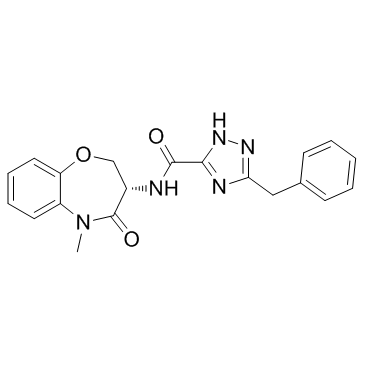| Cas No.: | 1622848-92-3 |
| Chemical Name: | GSK2982772,GSK-2982772,GSK 2982772 |
| Synonyms: | GSK2982772,GSK-2982772,GSK 2982772 |
| SMILES: | O=C(C1=NC(CC2=CC=CC=C2)=NN1)N[C@H]3COC4=CC=CC=C4N(C)C3=O |
| Formula: | C20H19N5O3 |
| M.Wt: | 377.4 |
| Sotrage: | 2 years -20°C Powder, 2 weeks 4°C in DMSO, 6 months -80°C in DMSO |
| Description: | GSK2982772 is a potent and ATP competitive RIP1 inhibitor with an IC50 of 16 nM. |
| In Vivo: | GSK2982772 is dosed orally 15 min prior to TNF and shows 68, 80, and 87% protection from temperature loss over 6 h, at doses of 3, 10, and 50 mg/kg, respectively. In the corresponding TNF/zVAD model, GSK2982772 shows 13, 63, and 93% protection from temperature loss over 3 h. GSK2982772 displays a good free fraction in blood in rats (4.2%), dogs (11%), cynomolgus monkeys (11%), and humans (7.4%). The inhibitor has a good pharmacokinetic profile across both rats and monkeys. GSK2982772 distributes into a range of tissues including the colon, liver, kidney, and heart at concentrations comparable to those of blood. However, GSK2982772 has low brain penetration in rat (4%) despite possessing good cell permeability (21×10-6 cm/s)[1]. |
| In Vitro: | GSK2982772 shows more than 1,000-fold selectivity for ERK5 over a panel of over 339 kinases at 10 μM. In stimulated cellular systems,GSK2982772 is also able to reduce spontaneous production of cytokines (IL-1β and IL-6) in a concentration-dependent fashion from ulcerative colitis explant tissue in overnight incubations. GSK2982772 produces a weak concentration dependent inhibition of hERG in human embryonic kidney (HEK-293) cells, with an estimated IC50 of 195 μM, and also shows a weak activation of the human Pregnane X receptor (hPXR) with an EC50 of 13 μM[1]. |

 DC Chemicals' products qualify for U.S. tariff exemptions. We guarantee no price increases due to customs duties and maintain stable supply, continuing to deliver reliable research solutions to our American clients.
DC Chemicals' products qualify for U.S. tariff exemptions. We guarantee no price increases due to customs duties and maintain stable supply, continuing to deliver reliable research solutions to our American clients.





















